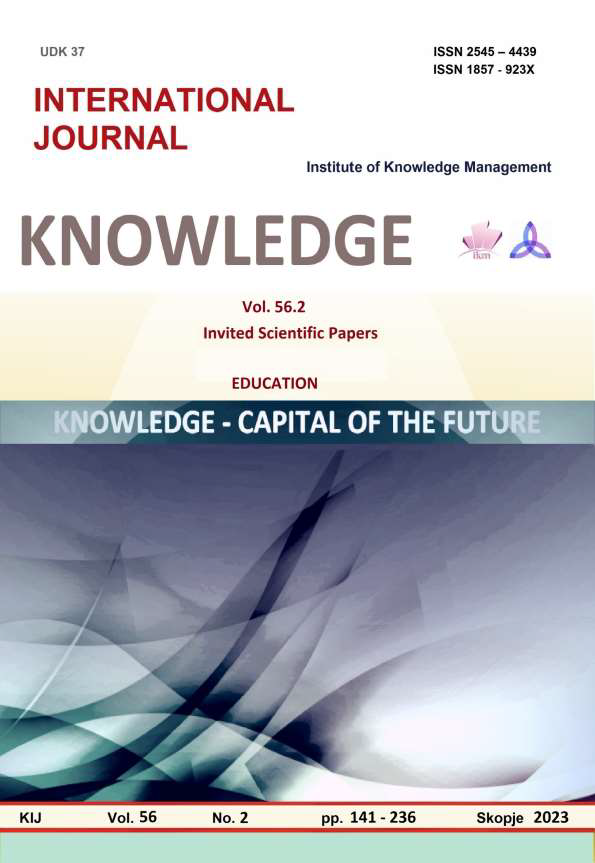THE ROLE OF MODERN TECHNOLOGIES IN LEARNING ENGLISH LANGUAGE DURING COVID-19 PANDEMIC
Keywords:
E-learning, on-line teaching, pandemic, E-platforms, modern technologies and English languageAbstract
In this paper, an attempt is made to emphasize the progressiveness in learning English in conditions of
pandemic crisis with the help of modern technologies, which undoubtedly in the past two years have played a crucial
role in this educational process. The success of learning the English language with the application of modern
technologies, in which the main place is occupied by distance learning with the use of electronic devices, depends
on several other factors. The equipment of higher education institutions with modern technologies forms the basis of
distance learning, but it is also very important that teachers and assistants are ready to be actively involved in the
electronic learning system with direct assistance to students, whether they are in the classroom or out.
The leading place in the study of English in the conditions of pandemic was the use of modern technological
systems that enabled direct connection and interactivity of a large number of immediate users with a high degree of
operability. Among them, the most common are: Google Classroom, Zoom, Schoology and Edmodo, The Moodle as
well as Google Meet and WhatsApp. However, recent research conducted during 2021 shows that the most used
platform internationally is WhatsApp. In decision making about which e-learning platform to be used the most
influential factors were accessibility and affordability while the unstable network is the biggest obstacle to the use of
platforms in online learning.
References
Bao, W. (2020). COVID -19 and Online Teaching in Higher Education: A Case Study of Peking University. Hum. BehavEmerg Tech 2 (2), 113–115. doi:10. 1002/hbe2.191
Basilaia, G. (2020). Replacing the classic learning form at universities as an immediate response to the COVID-19 virus infection in Georgia. International Journal for Research in Applied Science and Engineering Technology, 8(3), 101–108. https://doi.org/10.22214/ijraset.2020.3021
Basilaia, G., & Kvavadze, D. (2020). Transition to online education in schools during a SARS-CoV-2 coronavirus (COVID-19) pandemic in Georgia. Pedagog. Res. 2020, 5, em0060. (CrossRef)
Dollarhide, M. E. (2019, May 2). Social Media. Investopedia.www.investopedia.com/terms/s/social-media.asp
Kohnke, L., & Moorhouse, B. L. (2020). Facilitating synchronous online language learning through Zoom. RELC Journal, 003368822093723. https://doi.org/10.1177/0033688220937235
Madge, C., Breines, M. R., Dalu, M. T. B., Gunter, A., Mittelmeier, J., Prinsloo, P., & Raghuram, P. (2019). WhatsApp use among African international distance education (IDE) students: transferring, translating and transforming educational experiences. Learning, Media and Technology, 44(3), 267–282. https://doi.org/10.1080/17439884.2019.1628048
Mo, C.-Y., Hsieh, T.-H., Lin, C.-L., Jin, Y.Q., & Su, Y.-S. (2021). Exploring the Critical Factors, the Online Learning Continuance Usage during COVID-19 Pandemic. Sustainability 2021, 13, 5471. https://doi.org/ 10.3390/su13105471
Priyanto, H. (2009). Redesign of E-Learning Development In Indonesia. Journal for Vocational and Technical Education and Training, 9 (1). pp. 85-93. ISSN 1810-5416
Scholl, H. (2019). My Google Classroom Training Guide. Estalontech.
Singhal, T. (2020). A Review of Coronavirus Disease-2019 (COVID-19). Indian J. Pediatr. 87 (4), 281-286. doi:10.1007/s12098-020-03263-6
Souleles, N., Laghos, A., & Savva, S. (2020). From Face-To-Face to Online: Assessing the Effectiveness of the Rapid Transition of Higher Education Due to the Coronavirus Outbreak, in 15th International Technology, Education and Development Conference, Cyprus, November 9–10, 2020. doi:10.21125/iceri. 2020.0274
Toquero, C. M. (2020). Challenges and Opportunities for Higher Education amid the COVID-19 Pandemic: The Philippine Context. Pedagogical Res. 5 (4), em0063. doi:10.29333/pr/7947
Watermeyer, R., Crick, T., Knight, C., & Goodall, J. (2020). COVID-19 and Digital Disruption in UK Universities: Afflictions and Affordances of Emergency OnlineMigration. High Educ. (Dordr) 81, 623–641. doi:10.1007/s10734-020-00561-y
Zapier, M. (2018, April 25). A guide to Google Chat: Google Hangouts vs. Google Hangouts Chat vs. Google Hangouts Meet. Zapier. https://zapier.com/blog/googlehangouts-meet-guide/
Zhang, M. (2016). Teaching with Google Classroom. Packt Publishing Ltd.v.8n.3p.59
Zhang, W., Wang, Y., Yang, L., & Wang, C. (2020). Suspending classes without stopping learning: China’s education emergency management policy in the COVID-19 outbreak. J. Risk Finan. Manag. 13:55. doi: 10.3390/jrfm13030055





